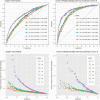Biological Aging Predicts Vulnerability to COVID-19 Severity in UK Biobank Participants
- PMID: 33684206
- PMCID: PMC7989601
- DOI: 10.1093/gerona/glab060
Biological Aging Predicts Vulnerability to COVID-19 Severity in UK Biobank Participants
Abstract
Background: Age and disease prevalence are the 2 biggest risk factors for Coronavirus disease 2019 (COVID-19) symptom severity and death. We therefore hypothesized that increased biological age, beyond chronological age, may be driving disease-related trends in COVID-19 severity.
Methods: Using the UK Biobank England data, we tested whether a biological age estimate (PhenoAge) measured more than a decade prior to the COVID-19 pandemic was predictive of 2 COVID-19 severity outcomes (inpatient test positivity and COVID-19-related mortality with inpatient test-confirmed COVID-19). Logistic regression models were used with adjustment for age at the pandemic, sex, ethnicity, baseline assessment centers, and preexisting diseases/conditions.
Results: Six hundred and thirteen participants tested positive at inpatient settings between March 16 and April 27, 2020, 154 of whom succumbed to COVID-19. PhenoAge was associated with increased risks of inpatient test positivity and COVID-19-related mortality (ORMortality = 1.63 per 5 years, 95% CI: 1.43-1.86, p = 4.7 × 10-13) adjusting for demographics including age at the pandemic. Further adjustment for preexisting diseases/conditions at baseline (ORM = 1.50, 95% CI: 1.30-1.73 per 5 years, p = 3.1 × 10-8) and at the early pandemic (ORM = 1.21, 95% CI: 1.04-1.40 per 5 years, p = .011) decreased the association.
Conclusions: PhenoAge measured in 2006-2010 was associated with COVID-19 severity outcomes more than 10 years later. These associations were partly accounted for by prevalent chronic diseases proximate to COVID-19 infection. Overall, our results suggest that aging biomarkers, like PhenoAge may capture long-term vulnerability to diseases like COVID-19, even before the accumulation of age-related comorbid conditions.
Keywords: Biological age; Biomarkers; Phenotypic age; UK Biobank.
© The Author(s) 2021. Published by Oxford University Press on behalf of The Gerontological Society of America. All rights reserved. For permissions, please e-mail: journals.permissions@oup.com.
Figures
References
-
- Yan L, Zhang H-T, Goncalves J, et al. . An interpretable mortality prediction model for COVID-19 patients. Nat Mach Intell. 2020;2(5):283–288. doi:10.1038/s42256-020-0180-7 - DOI
Publication types
MeSH terms
Substances
Grants and funding
LinkOut - more resources
Full Text Sources
Other Literature Sources
Medical
Miscellaneous


